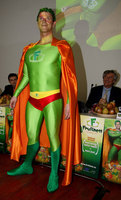Juicy new weapons to fight childhood obesity
 By 2010 there will be over 26 million obese and overweight children in Europe. This is the alarm bell sounded at Fruit Logistica 2008 by Margherita Caroli, President of the European Childhood Obesity Group. The promotion of fruit consumption is vital to counteract this trend, and Mr Fruitness represents a powerful ally to children in the fight against junk food.
By 2010 there will be over 26 million obese and overweight children in Europe. This is the alarm bell sounded at Fruit Logistica 2008 by Margherita Caroli, President of the European Childhood Obesity Group. The promotion of fruit consumption is vital to counteract this trend, and Mr Fruitness represents a powerful ally to children in the fight against junk food.A wider package of initiatives has recently been announced as part of “Fruitness enjoy it!, the three-year campaign to encourage fresh fruit consumption among children in Austria, Germany, the United Kingdom, Poland and Sweden.
The project - Fruitness.eu - is financed by the European Union, AGEA (Agricultural Payments Agency) and CSO (Fruit and Vegetable Services Centre), with the aim of promoting more natural eating habits to prevent childhood obesity.
In particular, it is opposing the influence of junk food and snacks rich in sugars and fats, with the natural goodness of peaches and nectarines, pears and kiwi fruits. For the second year running, shoppers are getting involved thanks to in-store activities being held in over 1,500 stores scattered throughout the five target countries.
The activities, which are being organised in co-operation with a number of leading large-scale retailers, involve the distribution of information materials, leaflets and a CD-ROM (4.5 million copies of which will be distributed during the three-year project) which contains an educational videogame suitable for young children.
The star of the campaign is Mr Fruitness, the superhero in the green leotard who draws his power from a daily diet of fruit. The colourful character is helping children to broaden their understanding of peaches, nectarines, pears, kiwi fruits and the benefits of a balanced diet.
This year, Mr Fruitness is looking for new ways to reach out to youngsters: “Among this season’s major new initiatives,” announced Luciano Trentini, Director of CSO, “are the recent agreements we have signed to promote fruit consumption, including in the independent greengrocers in Germany and Poland, and an initiative that we are promoting in primary schools in Cologne. Mr Fruitness is giving us the opportunity to reach out to children and teenagers, by encouraging them to adopt a healthier and more natural diet".
Warning bells were sounded by Dr Margherita Caroli, President of the European Childhood Obesity Group and member of the Scientific Committee of the “Fruitness enjoy it!” project.
“In Europe,” declared Dr Caroli, “the number of obese children is steadily increasing. In 2006 it was calculated that there were approximately 5 million obese children in the 5-18 year age group and another 17 million children who are overweight, and therefore at high risk of becoming obese. The annual increase is estimated to be approximately 1,200,000 children per year. Therefore in 2010, unless effective and widespread preventive strategies are implemented, it is forecast that there will be approximately 26,700,000 overweight and obese children in Europe.
“This figure in itself is terrible, but we must also consider that children are now becoming obese at an increasingly younger age, and the complications associated with their condition are commensurably serious. In fact, we are frequently seeing the occurrence, even in young children, of hyperinsulinaemia, hypertension, high cholesterol and fatty liver disease.
“One contributing factor in the onset of these complications is a diet lacking in fibre and antioxidants, and rich in processed foods loaded with added fats and sugars. Not only is the daily intake of fruit and vegetables vital in preventing obesity and its complications, it can also play a role in treating such complications.”
“The problem,” continued Margherita Caroli, “is that fruit consumption among European children is very limited, even in major fruit-producing countries such as Italy. In a recent study conducted on approximately 1000 children aged between 6 and 10, it was revealed that only 16 children – 1.6% of those surveyed - regularly eat fruit at school as a snack.
“There are a number of reasons for this low intake, but all of them can be tackled, provided that we establish a co-operative network that links doctors, producers, distributors, economists and politicians.
“We have to make children understand and appreciate fruit, using all the nutritional educational strategies at our disposal. We need to set up promotional channels that target children, with the aim of sending out a healthy message and emphasising the enjoyable aspects of these foods.
“The purchase of fruit and vegetable produce should be promoted by means of tax incentives.
“The distribution network needs to be broad and organised to permit comprehensive coverage of all European countries and all areas, including the least economically advantaged areas.
“Retail outlets should organise a variety of promotional activities, not just in terms of special offers, but also to communicate the added value of fruit and vegetables to shoppers, associating their fresh produce offering with health promotion campaigns.
“It is essential that many different professions - including those in the commercial and communications sectors – be committed to increasing fruit and vegetable consumption. Only then can we achieve the most important objective in the world: protecting the health of children.”
For more information, visit Fruitness.eu.

